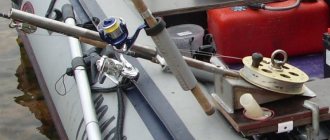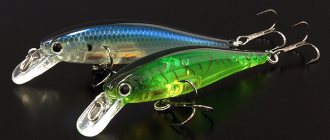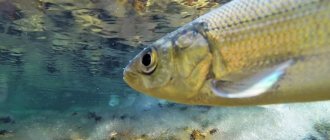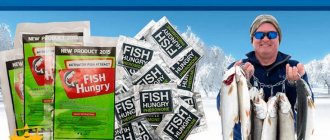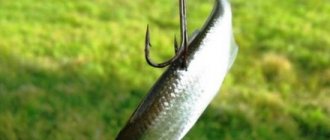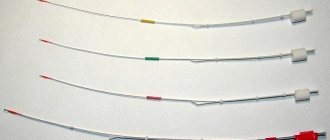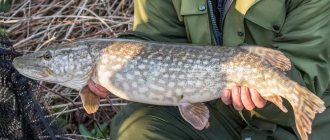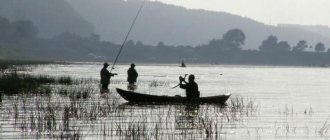Trolling fishing became possible after the rapid growth of available small-size watercraft and outboard motors designed for them. The prototype of this type of fishing in the form of a track has long faded into the background. After all, towing baits using mechanical force is much more convenient and comfortable for the fisherman, and mobility when searching for promising sites for predators is not the least important thing in fishing.
Frequent and quick changes of places, the possibility of fishing large areas and varying depths made trolling the surest way to get really trophy fish, but at the same time they played a cruel joke on this method, giving it the reputation of a type of fishing aimed at exterminating the brood stock of a predator. It is worth noting that trolling is not a legal way of catching fish in all regions of our country, so when planning fishing trips, you should pay special attention to this factor, clarifying the interpretation of the local law.
How to organize trolling fishing, ensuring the process in terms of the technical part and auxiliary devices, as well as the basic hunting strategies, the fisherman will become aware of after reading this article.
What is trolling
Trolling is a modern way of catching fish using a motorized boat with a set of gear and bait, equipped with gadgets for navigation and echolocation that help search for trophies in vast water areas. In trolling fishing, the role of the fisherman is to present the bait to a certain depth and distance, directly control the bites and then reel in the hooked fish.
The wiring, or rather towing of the nozzle, is carried out due to the movement of the boat. At the time of fishing, you can use and control several gear with similar parameters with different types of bait, fishing at depth levels that differ in size from each other. This fishing method is intended for catching marine and freshwater predatory fish using bait of artificial and animal origin.
Gliders
An autonomous glider is a small flat floating rectangle, red, orange or yellow, with a loaded bottom. Its front edge is beveled so that when towing the glider is carried away from the boat, to the right for a right-handed glider and to the left for a left-handed glider.
Using gliders, three or four anglers can quickly fish giant areas, making this technique ideal for finding fish. At the same time, due to the fact that the gliders are attached to the fishing lines, the latter are protected from tangling. Only a few basic rules need to be followed.
When baits that are the same or diving to the same depth are towed, the gliders to which they are attached should be positioned as far apart as possible. Ideally, on different sides of the boat. They are installed first. Shorter rigs with divers and their gliders should be positioned closer to the sides of the boat. If you want to use lures of different depths, always place the shallowest crankbait on the longest rig, away from the boat.
Keep the glider as far away from the boat as possible. Success will depend on this. The stakes will increase sharply because the noise and shadow of an approaching boat frightens the walleyes, causing them to ignore the approaching baits. This is especially true for clean, clear water.
However, clean water is not mandatory. Some of my most memorable catches have come in murky water while trolling 30 meters off the windward shore. If this situation arises, move all gliders to the side of the boat closest to the shore. This will allow you to stay in much deeper water where you won't spook the fish with your boat.
Varieties
Trolling fishing has several directions and gradation by variety depending on the fishing location. There are such types of fishing as:
- sea trolling;
- river fishing method on moderate currents;
- trolling fishing on a small river.
In addition to the differences associated with reservoirs, trolling fishing is divided into thematic, for a specific type of predator, and general, in which the type of trophy is not initially placed at the forefront of the fishing result and is carried out at random. Thematic fishing mostly includes fishing in fresh water bodies, when one purposefully hunts for pike, pike perch or catfish, using specially selected baits for these purposes.
Sea fishing is more difficult to plan for a specific type of fish due to the wide variety of inhabitants of the water areas. Such fishing strategies are similar to a lottery, when absolutely any fish can become a trophy in the catch. In addition to the above types of methods, trolling is divided into basic and search. The main one is when a predator is caught only from a moving boat. Search - when areas of accumulation of fishing objects found by towing baits are subsequently fished with classic spinning types of hunting, anchoring a swimming device at a certain point.
Enveloping contours
Another good trolling technique. It is used if you, having a pair of wobblers at the back and moving with the wind, want to fish the jagged edge of an underwater hill. The most lethal point in this case is the cleft, a sharp depression. But how to effectively fish this place?
Professional trolling expert Doc Samson says:
When fishing narrow, local spots with sharp corners, most fishermen make smooth maneuvers, trying to maintain constant line tension. In this case, the wobblers will never reach the target - the crack where the pike perch are hiding. The boat pulls the bait too far from the ravine, the pike perch simply do not have time to react.
Instead of going around the creek, I steer the boat along the creek. At the same time, my wobblers are located 40 meters behind, which ensures that the baits will pass exactly through key places.
Use echo sounders with cards like Lowrance LCX-113C. It is very easy to navigate and follow any bottom topography on most bodies of water. I can make adjustments to the boat’s trajectory at any time as soon as I see something interesting.
The main task is to make the bait follow the contour of the valley. The next step after turning is to give the bait the necessary acceleration. As soon as the wobbler reaches the killing area, sharply increase the speed to 3-6 km/h. After a few seconds, depending on the angle of the turn, your boat will jump out into the shallow area. Immediately turn the boat's bow back toward the edge of the creek and put the boat in neutral. The chart plotter will help you make this maneuver because you can see how the boat is positioned relative to the break.
If everything is done correctly, your bait will slowly float up and oscillate inside the ravine at this moment. It's a very good idea to stop here for a few seconds. Then, immediately engage the gear and increase the speed to 5 km/h or higher. At this moment, pike perch bites usually occur. Continue trolling at this speed for a few more seconds, then return to normal trolling mode. Keep your speed constant until you reach the next section. Repeat the maneuver.
Between the points, try to stay at a depth relative to the edge. The probability of meeting big fish here is very high.
If I catch several walleyes in a row at one spot, I stop searching for fish. I quickly reel in the lures, turn the boat around and start trolling into the wind. I often fish this way on small, local spots that seem better suited to jigging. But, I am convinced that pike perch only react to uneven movements of wobblers. Jig baits and jig wiring do not cause any interest to them.
Trolling tackle
The fundamental gear for trolling fishing is the spinning rod. Regardless of the types of trolling, a set of spinning equipment must have increased power that can withstand serious overloads. Excessive loads are not only associated with the occurrence of efforts when fighting massive caught fish and retrieving heavy deep-sea baits, but also arise from frequent hooks of fishing tools on underwater obstacles, which is considered an ordinary, working case in this area of hunting. Let's look at the main criteria for selecting a set of tackle from a more thorough perspective, focusing on each element separately.
Rod
The material of a spinning rod for trolling must meet the requirements of strength combined with the properties of high plasticity. The weight of the rod for this method of fishing is not considered the most important criterion, because the fisherman does not constantly hold the tackle in his hands, but handles it periodically, which does not cause fatigue. Consequently, even blanks with reinforced winding rings made of fiberglass are quite suitable for the frame of the gear.
Length
It is inconvenient to use long tackle in a boat, so the optimal blank lengths are considered to be rods in the range of 2.3 - 3 meters. This spinning rod can be used comfortably when feeding and adjusting the course of the bait, as well as adjusting trajectories, avoiding obstacles that arise along the way.
Test
Trolling gear is selected with weights starting from 20 grams. This is the optimal value with which you can drive the wobbler in the surface water horizon, knowingly introducing the risk of unexpected hooks that seriously load the form. Practice shows that when hunting on small rivers, rods with a test range of 20–50 grams are suitable. When fishing in large rivers, lakes and reservoirs, 40–80 grams, and the sea direction of trophy production is carried out with gear with tests ranging from 100 grams and above.
Build
To ensure guaranteed self-hooking of pecked fish, the best results are shown by medium-fast and fast action gear. Slow blanks do not guarantee reliable hooking due to the softness and high degree of shock absorption of the material, which gives the fish a chance to escape, spitting out the bait weakened by the tension of the cord. Ultra-fast blanks increase the reliability of hooking, but easily break when hooked and a sharp bite from a fish.
Coil
In the configuration of tackle for trolling fishing, inertia-free traction and multiplier reels with large, capacious spools are used.
Important! In the design of the reel, special importance is attached to fine adjustment of the clutches, which helps preserve the rod and bait when snags occur.
When catching fish in fresh waters, reels starting from 3500 units are used. For sea fishing, it is preferable to install bulky multipliers with a line counter and a spool reserve of hundreds, or even a thousand meters. Recently, miniature multipliers have appeared on sale, suitable for trolling fishing in small reservoirs for small trophies.
fishing line
The priority of equipment for trolling fishing is to install a non-stretch braided cord, which transmits the bite signal more clearly and quickly and takes up less volume in the spool, having high breaking load limits with smaller diameters. Multi-colored braided cords are comfortable for fishing; by the coloring of the sections, it is visually easy to determine the length of the unwinding of the tackle. Monofilament fishing lines, due to the high stretch coefficient and large diameters of the thread, are rarely used in trolling fishing and in very specific hunting conditions at short distances for carrying bait.
Trolling with a downrigger
Casting weighted artificial baits allows you to troll them at depths of up to about 10 - 15 meters. For fishing at a depth of 10 - 20 meters, a diving glider is used, fixed at a distance of 2.5 - 4 meters from the bait. These sinkers are used to lower the bait to the desired depth, but when landing fish, the resistance of the sinker, often made of metal or plastic, creates additional stress on the line. Past generations of sports fishermen had to hang heavy lead weights on a fishing line to troll at great depths. Thousands of large pikes. North American trout and salmon were caught using sinkers weighing 3 - 5 kilograms and heavy sea fishing gear. This type of sport fishing was very productive.
A downrigger consists of a spool with wire line, an arrow and a block through which a single-strand or braided line passes. Most of these tackles have a reeling system, a line counter and a rod holder. The sinker is attached to the end of the wire. The mechanism for releasing the line is placed either on the wire or on the sinker itself.
If you use one downrigger to troll several baits, then additional mechanisms are installed higher on the wire to release the fishing line.
These mechanisms hold the line at a distance of 3 to 30 meters from the bait, depending on the depth at which the fish is holding, water clarity and other factors.
The weight of the sinker depends on each individual downrigger. The heaviest sinkers weigh approximately 6 kilograms. They are often shaped like a torpedo with wings.
It is important to note here the importance of an echo sounder in determining the desired depth. It is also useful for identifying predators that frequent specific depths. With this information, you can troll one lure slightly above where the fish are, another below it, and two more directly at the depth where the fish are holding.
The downrigger can be used on boats of any size. The rod is installed either in the holder of the downrigger itself. or next to it. For fishing with a downrigger, special rods are sold that allow you to make a more powerful hook when biting. Typically, such rods are equipped with a baitcasting reel with a relatively thin line, which can, however, withstand the trolling load at a speed of 3 - 4 knots.
The line release mechanism must be carefully adjusted. It can be made in the form of a clamp or spring, which, when bitten, releases the fishing line so that the angler can catch the fish using the rod. When the water warms up, predators move to those water layers whose temperature suits them more. Sometimes they go to depths of 30 - 50 meters. A temperature indicator attached to the downrigger cord can show you what the temperature is where the bait is located.
Trolling boat
For marine fishing, boats of varying power are equipped, allowing long passages and withstanding difficult weather conditions. Choosing a boat for the more familiar type of troll in river and lake conditions is much simpler and unpretentious.
Important! Any PVC boat, wooden, plastic or metal model that has a transom or a device for attaching a motor is suitable for trolling.
The power of the motor, whether electric or gasoline, depends on the weight and carrying capacity of the boat. For fishing, the boat is equipped with comfortable seats and various devices that help hold gear and navigation gadgets, store bait and caught trophies. All this tuning of the boat is adjusted to the individual needs and preferences of the fisherman, meeting the requirements for safe operation of the boat and comfortable fishing.
Auxiliary equipment
Beginner fishermen who have just begun to master trolling fishing should have an understanding of auxiliary equipment that will provide additional quality and convenience for fishing. The presence of these elements will determine the saving of expensive fishing time, as well as the quantitative component of the catch.
This does not mean that it is impossible to carry out trolling without these gadgets and devices, because you can purchase them not at once, but as needed, over time getting a taste and already understanding the essence of this kind of fishing, or you can not use them at all, ignoring convenience and relying purely on luck . For example, the presence of a GPS navigator will help you quickly find a trajectory marked on the lake, which during a previous fishing trip showed a significant result in terms of trophies obtained and was prudently entered into the device’s memory. We will look at some important auxiliary things in a little more detail.
Echo sounder
There is no doubt that an echo sounder will not be an unnecessary extra in a boat designed for trolling. Information about the bottom topography is fully capable of becoming the initial data for the planned fishing strategy. Having this device in hand, the angler will quickly become familiar with the territory intended for fishing, making a preliminary walk around it and identifying promising points. In addition, some modern gadgets in this direction, in addition to the bottom topography, can show the presence of a trophy, which will allow you to place the bait in the right place and in the exact water horizon and be prepared for a possible reaction of the fish in the form of a bite.
A variety of echo sounders with different capabilities and price levels allows you to choose a device that suits your budget and your needs. Some gadgets, combining echolacing with navigation at the same time, will become an indispensable assistant in conducting repeated fishing trips on the same body of water.
Downrigger
This device helps to accurately guide the bait in a certain water horizon. The downrigger has nothing to do with electronic devices, but it copes with its function quite effectively, giving the bait the required depth stroke regardless of the distance it is released from the boat.
The essence of the mechanism is based on the principle of operation of a miniature winch attached to a boat, using a cord to support a load moving in the desired horizon. Connected by a clip to the main cord of the tackle, when a fish bites, the weight spontaneously detaches from the stretching thread with the bait, allowing you to freely remove the hooked fish.
Other devices
Other practical and useful equipment includes rod holders that can free the fisherman from constantly holding the gear in his hands, allowing him to visually monitor the progress of fishing, reacting only to the moment a bite occurs. In trolling from boats and boats, where several equipment is used simultaneously, various devices are often used to regulate the movement of baits and help ensure not only depth and distance parameters, but also prevent tangling of cords. In particular, sinkers and bouncers are responsible for the level indicators of the stroke, and outriggers and paravanes are responsible for their spreading and not intersecting the trajectories of the cords during wiring.
How to deepen a wobbler when trolling
Artificial fish are buried in two ways. The first method is based on the speed component of the wiring when the boat is moving. The second method requires the use of specialized equipment in the form of a device called a downrigger. A trolling deepener, a downrigger, is a combination of weight and line that moves behind a swimming craft in a certain water horizon, due to its specific setting. Using a clip or similar fastening, a bait is attached to the device in tandem, which is guaranteed to be pulled behind the boat in the desired horizon.
The first method is more suitable for river fishing or trolling on lakes with depths not exceeding fifteen meters. The wobbler is brought to the surface of the water by casting or simply releasing the main line directly behind the boat. Having released the bait at a distance of 20–30 meters, the reel bracket is closed. Having stopped the cord, the wobbler, due to the design of the blade, begins to dive to a given depth. Having reached the required meters of immersion, uniform wiring begins in tune with the movement of the boat.
Important! By increasing the speed of movement, the depth of immersion also increases, otherwise the bait goes higher. By winding the cord at speed, the immersion level is adjusted. The shorter the line, the higher the bait goes in the water level.
Lures
Wobblers for trolling are the classic and most common bait for the method we are considering. Lure manufacturers produce deep-sea wobblers with factory game settings specifically for this type of hunting. Cranks, fats, shads and minnows are the most promising types of wobblers for fishing . In addition to wobblers, the troll uses oscillating spoons and loaded silicone. When focusing on silicone baits, it is worth noting the prospects of such species as ripper and spinnerbait.
Lure sizes are selected based on fishing conditions, as well as the amount of fish expected to be caught. In some cases, fishermen use not only artificial baits, but also rigs with dead fish as bait. Rotating spoons, due to the high probability of twisting the cords, are rarely used in trolling, and if they are used, then in conjunction with a nylon cord.
Search for a predator
Even having determined the method of catching a predator, the angler needs to find active fish. In trolling fishing this is done using an echo sounder. A motor boat equipped with this gadget will help you quickly solve the problem of finding predators in vast water areas and successfully start fishing. The absence of an echo sounder significantly complicates the task, requiring the fisherman to know the habits of the object being fished and the ability to find fish based on certain surface features, weather conditions and structural features of the reservoir. Thus, almost all freshwater predators like to hunt in places with the presence of aquatic vegetation and its boundaries, as well as in areas near the bottom that have anomalies in the form of depth lines, holes, the presence of driftwood and snags. With an increase in atmospheric pressure, the predator moves to shallow water, and when it decreases, it moves to the depths. Intense heat slows down fish, forcing them to sink to the bottom and take slow-moving baits.
Trolling in shallow water
Shallow-water zones include water areas with depths of up to three meters. These are often favorite habitats for small pike, pike perch and asp. Trolling on rivers and lakes in shallow waters does not differ in its strategies. The fisherman uses wobblers with a small depth, medium-sized oscillating spoons and silicone of different sizes. Fishing with dead fish pays off. Lures are placed over algae and near the boundaries of clear water. Straight-line even pulls and pulls with pulls at low boat speeds are successful.
Trolling in the depths
Fishing by trolling on a river with depths of over five meters and the presence of even moderate currents will require powerful gear. For fishing, deep-sea wobblers, heavy spoons and coated silicone are used. Wiring is associated with strong vibrations from the play of the bait and resistance to the forces of the current; moreover, the catches include large and strong fish, which can crush the tackle if not properly fished. The fisherman will need to develop fishing skills, experience of which is easiest to gain by starting fishing in shallow waters. According to the depths, the bait leads near the bottom, even sometimes touching the ground. Uniform wiring alternates with pulling, short winding of the cord followed by lowering, movements from side to side. The boat is driven at medium and high speeds.
What is the essence of trolling?
Trolling on the river is a method of catching a predator, the essence of which is that the retrieval is carried out from a floating vessel in motion. Essentially, it is moving on a boat while towing bait. A wobbler in continuous motion attracts predatory fish much more strongly. In summer, during the hottest periods, this technique gives a chance for a record catch, despite the fact that the fish are quite passive.
Both hull boats and inflatable models are suitable for trolling. You can easily and easily catch large catfish, perch, and pike perch in deep-sea reservoirs, on navigable rivers and lakes using this technique. The main thing is to choose the right bait and navigate well according to the echo sounder data.
How to fish by trolling
Regarding trolling fishing techniques, it is worth paying attention to two main points of guiding baits along rivers. Wiring can be done both with the flow and against it. When choosing fishing tactics with the current, special attention is paid to the speed of the boat, which should allow the bait to play and not float freely in the water flow.
Important! The correct play of the bait is distinguished by the peculiar uniform rhythmic twitching of the quiver-type tackle, without any failure.
Driving baits against the current in selecting speeds is easier, because the animation of the simulator is achieved even with minimal movement as a result of the force of the water flow. In this case, an important parameter is the release length of the bait, which affects the depth of its stroke. During the reeling process, the angler must monitor the hooks, lowering the line in a timely manner and slowing down, and when reeling in the cords, pay attention to the trajectory of the bait, preventing the thread from getting on the motor propeller.
